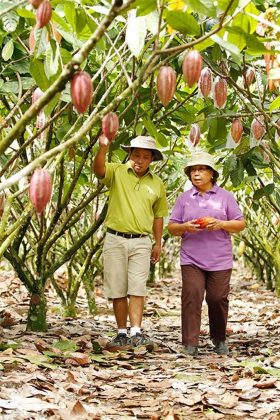BEHIND every sweet bite of chocolate is a lot of sweat, blood, and tears: at least, this is what we gleaned from a talk by Collabox on July 7 (World Chocolate Day) with stakeholders in the Philippine chocolate industry called “Elevate Philippine Chocolate.”
Dalareich Chocolate House’s Dalareich Polot (called “Bohol Chocolate Princess” on their website) said that their story began with tablea that her parents made, the cocoa tablets that one dissolves in water to make a drink. “We were able to go to college, all of us, because of that,” she said during the webinar. According to their website, her parents had quit their day jobs as a street cleaner and a tricycle driver to focus on the cacao trade. Cacao certainly took her places: she was able to get a scholarship to Cacaolab of Ghent University in Belgium. “I realized that they didn’t know we have cacao in the Philippines. They were surprised that we had that,” she said, adding, “We have cacao in the backyard; we drink hot chocolate in the morning.”
In Belgium, she realized that tablea was akin to 100% dark chocolate. She let her Belgian peers taste it, and reintroduced it to the Philippine community there. “We should innovate with tablea; make it really fine, and sell it to the world,” she said. The effort paid off, and Dalareich 100% Unsweetened Chocolate won a gold in 2019 at London’s Academy of Chocolate under the Drinking Chocolate category. “It opened my mind that we should say to the world that we have the beauty of cacao in the Philippines.”
One of the pioneers of bringing Philippine chocolate to the world stage is Malagos Chocolate, which has been winning international awards since 2015. To date, it has won, among others: the Gold Award for 2020 International Chocolate Awards-World Drinking Chocolate (Direct Traded), the Gold Award for 2020 International Chocolate Awards-World Drinking Chocolate (Growing Country), and several Bronzes from the Academy of Chocolate Awards. The journey has been long, though: they started out in farming and exporting in 2003, but began making chocolate in 2012. Chocolate maker Rex Puentespina recalled that he began by joining mall shows — and got calls from tasters and buyers who were nibbling incognito. “We have one foot in the door. It’s easier to sell rather than [doing] door-to-door sampling.” His first international trade show was Germany’s Anuga in 2015; one of the biggest food fairs in the world.
Meanwhile, Froilan Pamintuan, Commercial Attache for the Philippine Trade and Investment Center (PTIC)-Paris, recalled how he and seven chocolate makers (including Dalareich and Malagos) conquered the 2017 Salon du Chocolat.
Apparently, while the Department of Trade and Industry (DTI) had been helping place products like Philippine chocolate in international fairs, they realized that joining large fairs impeded their efforts, drowned as they were in the large variety of products offered. They switched strategies and decided to join smaller niche trade shows instead. They found out in advance that Mr. Puentespina’s farm had been chosen as a finalist for the Cocoa of Excellence awards, which were due at the Salon du Chocolat. The PTIC had managed to get funding from their counterparts in the Philippines — just enough for a small booth in the show, but what luck: it was right by the entrance, which got them a lot of attention. “We were already swamped by visitors,” Mr. Pamintuan recalled. “I think it was the very first time that the Philippines was featured in an international chocolate or cacao pavilion.”
On this note, Mr. Puentespina said that to go international, “You have to have a very local brand first. Europe is very far. I’m also biased [towards] Asia, and we have a big chance also, for exporting our product. When exporting, you better be ready with the values — and a lot of things.”
Mr. Puentespina was asked if he had any secrets for going international. “There’s no secret. The quality of the cocoa bean has to be there.”
“You have to hand it to the farmer who processed it. A chocolate maker can only do so much. A chocolate maker cooks it, or molds it — but a farmer takes care of it for years.” — J.L. Garcia





